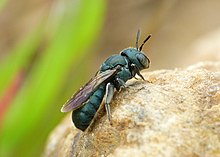|
Xylocopinae
 The subfamily Xylocopinae (family Apidae) occurs worldwide, and includes the large carpenter bees (tribe Xylocopini), the small carpenter bees (tribe Ceratinini), the allodapine bees (tribe Allodapini), and the relictual genus Manuelia (tribe Manueliini).[1] SubdivisionsThe Tribes of Xylocopinae are:
DescriptionSome Xylocopinae have a cavity between the thorax and abdomen, called acarinarium, which provides accommodation for a colony of predatory mites, cleaning their hosts of external parasites.[3] The vast majority of the Xylocopinae species make nests in dead wood, stems, or pith, and while many are solitary, many are also communal or primitively social. Some genera of Allodapines commonly form eusocial colonies. See alsoReferencesWikimedia Commons has media related to Xylocopinae.
|
||||||||||||||||||||||||||
